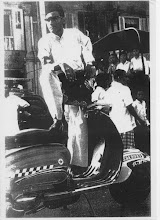 Proses sandblasting merupakan antara proses terpenting dalam restorasi kenderaan-kenderaan lama, ini kerana dengan menjalankan proses sandblasting, permukaan besi akan bebas daripada cat lama, simen dan karat yang boleh menyebabkan proses mewarna semula permukaan besi tersebut menjadi sukar. Berikut adalah sedikit maklumat berkenaan sandblasting yang aku jumpa dalam wikipedia :-
Proses sandblasting merupakan antara proses terpenting dalam restorasi kenderaan-kenderaan lama, ini kerana dengan menjalankan proses sandblasting, permukaan besi akan bebas daripada cat lama, simen dan karat yang boleh menyebabkan proses mewarna semula permukaan besi tersebut menjadi sukar. Berikut adalah sedikit maklumat berkenaan sandblasting yang aku jumpa dalam wikipedia :-Sandblasting or bead blasting is a generic term for the process of smoothing, shaping and cleaning a hard surface by forcing solid particles across that surface at high speeds; the effect is similar to that of using sandpaper, but provides a more even finish with no problems at corners or crannies. Sandblasting can occur naturally, usually as a result of particles blown by wind causing eolian erosion, or artificially, using compressed air. An artificial sandblasting process was patented by Benjamin Chew Tilghman on October 18, 1870.
Historically, the material used for artificial sandblasting was sand that had been sieved to a uniform size. The silica dust produced in the sandblasting process caused silicosis after sustained inhalation of dust. Several countries and territories now regulate sandblasting such that it may only be performed in a controlled environment using ventilation, protective clothing and breathing air supply.
Historically, the material used for artificial sandblasting was sand that had been sieved to a uniform size. The silica dust produced in the sandblasting process caused silicosis after sustained inhalation of dust. Several countries and territories now regulate sandblasting such that it may only be performed in a controlled environment using ventilation, protective clothing and breathing air supply.
Maka kalau mengikut penerangan diatas, proses sandblasting ini sebenarnya bermula secara natural sebelum proses sandblasting ciptaan manusia diadakan dan kemudian apabila manusia mendapat idea untuk meniru sandblasting dari alam semulajadi maka terciptalah proses ini pada tahun 1870.
 Disebabkan kekangan kewangan aku hanya mampu untuk menghantar beberapa bahagian (yang difikirkan penting) untuk dihantar menjalani proses sandblasting ini, bahagian-bahagian tersebut adalah
Disebabkan kekangan kewangan aku hanya mampu untuk menghantar beberapa bahagian (yang difikirkan penting) untuk dihantar menjalani proses sandblasting ini, bahagian-bahagian tersebut adalaha. Frame / Rangka Badan
b. Mudguard Depan dan Belakang
c. Fork
Proses tersebut mengambil masa lebih daripada 24 jam untuk dibuat dan hasilnya boleh dilihat seperti dalam gambar.





